Why Digital Technology Matters in Managing People at the Workplace
VerifiedAdded on 2023/06/10
|9
|2673
|318
Report
AI Summary
This report examines the pivotal role of digital technology in modern workplaces, particularly in enhancing people management. It begins by outlining various digital technologies such as cloud computing, workforce digital security, AI-powered virtual assistants, immersive team apps, and group meeting systems. It then details how the COVID-19 pandemic accelerated the adoption of these technologies, emphasizing the increased reliance on AI, machine learning, and virtual reality for remote work and improved decision-making. The report highlights the benefits of digital technology, including increased transparency, enhanced employee engagement, improved knowledge sharing, better customer satisfaction, and improved remote working capabilities. However, it also addresses the disadvantages, such as the loss of interpersonal communication skills, increased dependency on technology, high costs, employee resistance to change, and data security risks. The report concludes that while digital technology is crucial for organizational success, businesses must carefully manage its implementation to mitigate potential drawbacks.
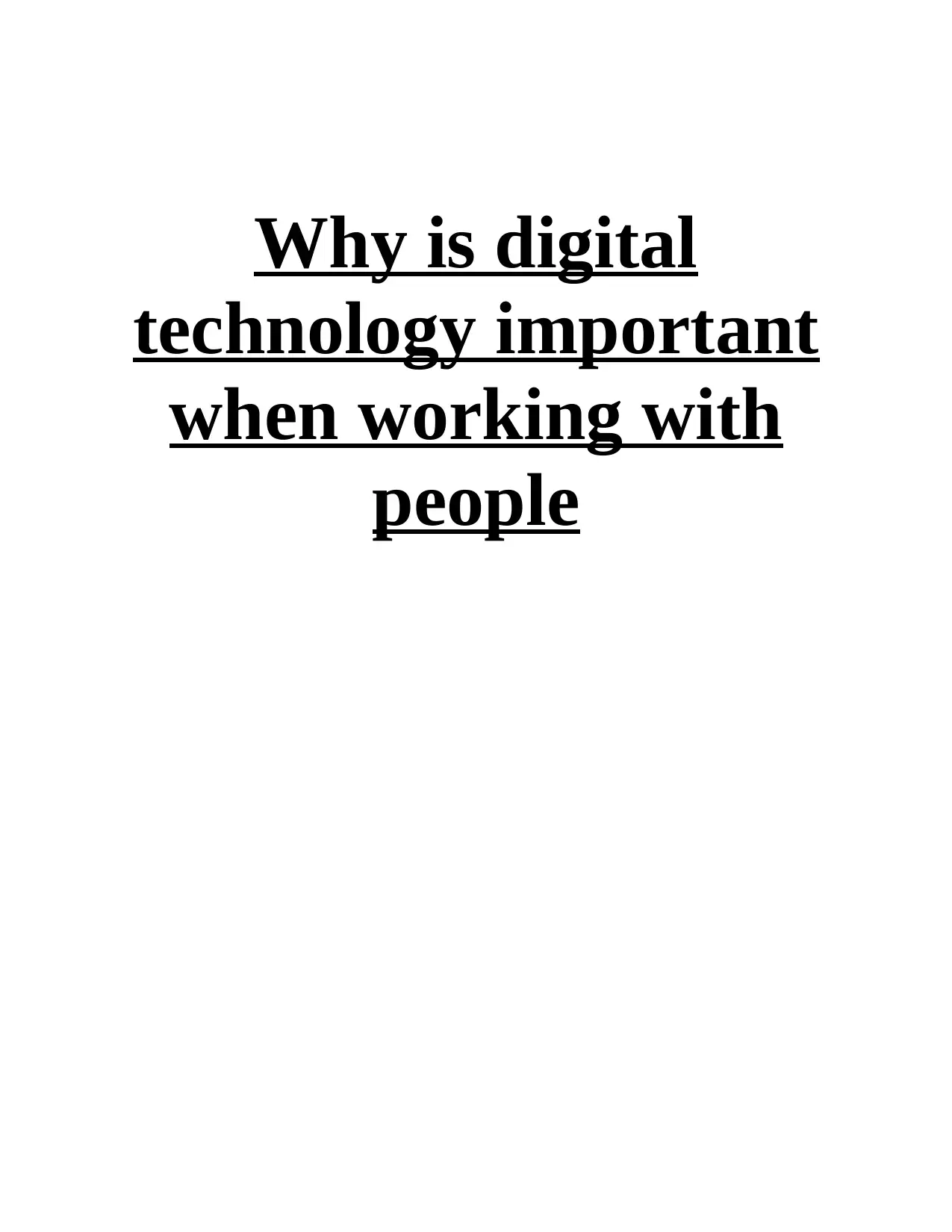
Why is digital
technology important
when working with
people
technology important
when working with
people
Paraphrase This Document
Need a fresh take? Get an instant paraphrase of this document with our AI Paraphraser
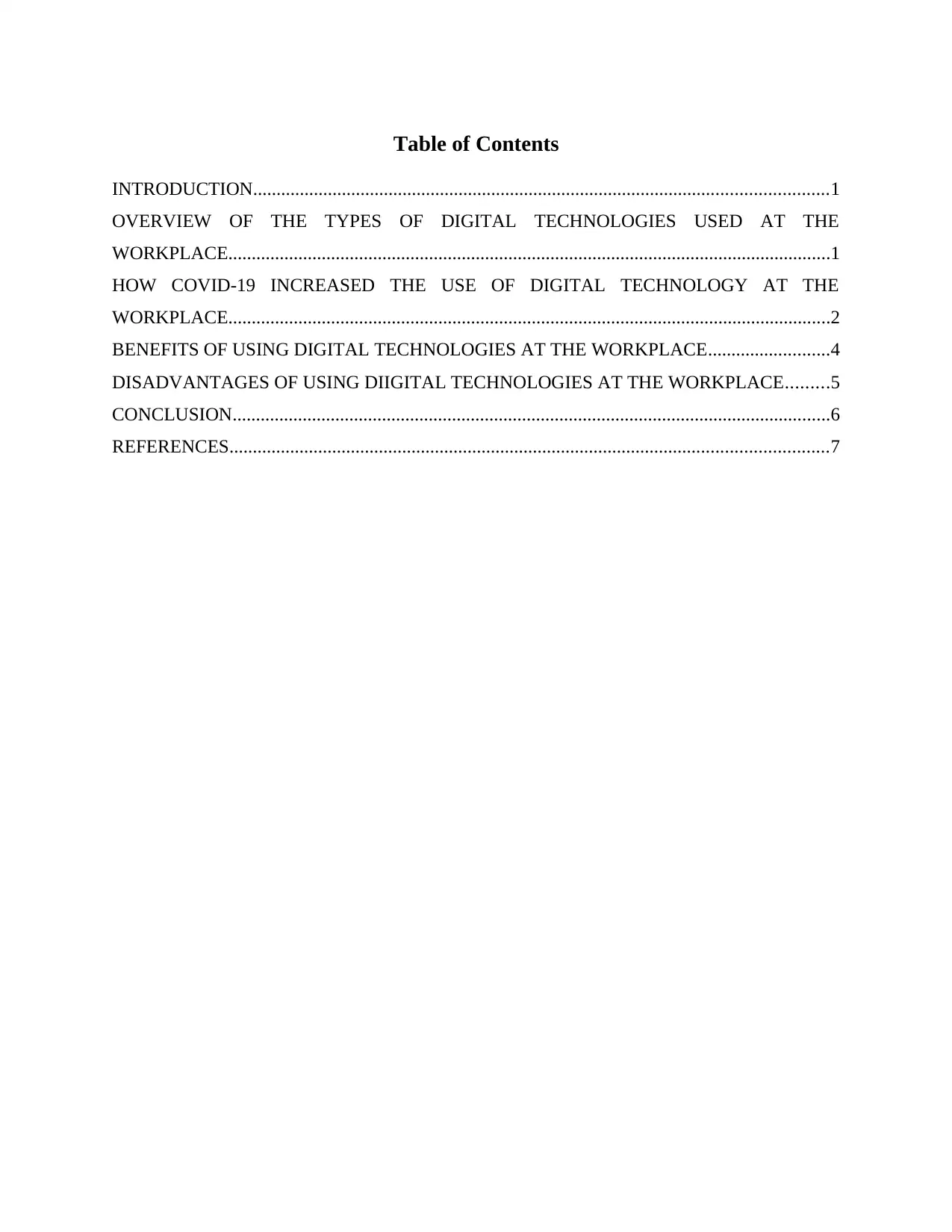
Table of Contents
INTRODUCTION...........................................................................................................................1
OVERVIEW OF THE TYPES OF DIGITAL TECHNOLOGIES USED AT THE
WORKPLACE.................................................................................................................................1
HOW COVID-19 INCREASED THE USE OF DIGITAL TECHNOLOGY AT THE
WORKPLACE.................................................................................................................................2
BENEFITS OF USING DIGITAL TECHNOLOGIES AT THE WORKPLACE..........................4
DISADVANTAGES OF USING DIIGITAL TECHNOLOGIES AT THE WORKPLACE.........5
CONCLUSION................................................................................................................................6
REFERENCES................................................................................................................................7
INTRODUCTION...........................................................................................................................1
OVERVIEW OF THE TYPES OF DIGITAL TECHNOLOGIES USED AT THE
WORKPLACE.................................................................................................................................1
HOW COVID-19 INCREASED THE USE OF DIGITAL TECHNOLOGY AT THE
WORKPLACE.................................................................................................................................2
BENEFITS OF USING DIGITAL TECHNOLOGIES AT THE WORKPLACE..........................4
DISADVANTAGES OF USING DIIGITAL TECHNOLOGIES AT THE WORKPLACE.........5
CONCLUSION................................................................................................................................6
REFERENCES................................................................................................................................7
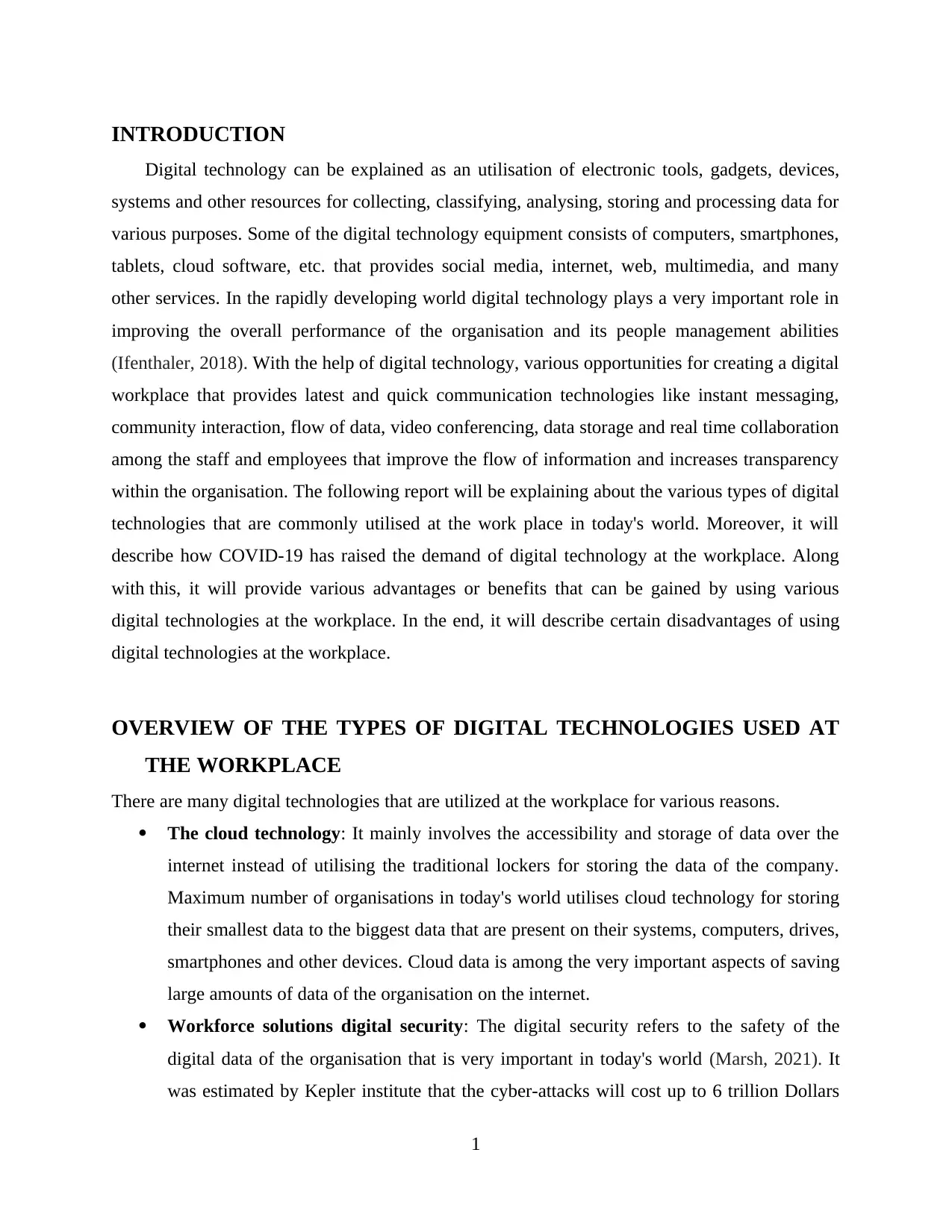
INTRODUCTION
Digital technology can be explained as an utilisation of electronic tools, gadgets, devices,
systems and other resources for collecting, classifying, analysing, storing and processing data for
various purposes. Some of the digital technology equipment consists of computers, smartphones,
tablets, cloud software, etc. that provides social media, internet, web, multimedia, and many
other services. In the rapidly developing world digital technology plays a very important role in
improving the overall performance of the organisation and its people management abilities
(Ifenthaler, 2018). With the help of digital technology, various opportunities for creating a digital
workplace that provides latest and quick communication technologies like instant messaging,
community interaction, flow of data, video conferencing, data storage and real time collaboration
among the staff and employees that improve the flow of information and increases transparency
within the organisation. The following report will be explaining about the various types of digital
technologies that are commonly utilised at the work place in today's world. Moreover, it will
describe how COVID-19 has raised the demand of digital technology at the workplace. Along
with this, it will provide various advantages or benefits that can be gained by using various
digital technologies at the workplace. In the end, it will describe certain disadvantages of using
digital technologies at the workplace.
OVERVIEW OF THE TYPES OF DIGITAL TECHNOLOGIES USED AT
THE WORKPLACE
There are many digital technologies that are utilized at the workplace for various reasons.
The cloud technology: It mainly involves the accessibility and storage of data over the
internet instead of utilising the traditional lockers for storing the data of the company.
Maximum number of organisations in today's world utilises cloud technology for storing
their smallest data to the biggest data that are present on their systems, computers, drives,
smartphones and other devices. Cloud data is among the very important aspects of saving
large amounts of data of the organisation on the internet.
Workforce solutions digital security: The digital security refers to the safety of the
digital data of the organisation that is very important in today's world (Marsh, 2021). It
was estimated by Kepler institute that the cyber-attacks will cost up to 6 trillion Dollars
1
Digital technology can be explained as an utilisation of electronic tools, gadgets, devices,
systems and other resources for collecting, classifying, analysing, storing and processing data for
various purposes. Some of the digital technology equipment consists of computers, smartphones,
tablets, cloud software, etc. that provides social media, internet, web, multimedia, and many
other services. In the rapidly developing world digital technology plays a very important role in
improving the overall performance of the organisation and its people management abilities
(Ifenthaler, 2018). With the help of digital technology, various opportunities for creating a digital
workplace that provides latest and quick communication technologies like instant messaging,
community interaction, flow of data, video conferencing, data storage and real time collaboration
among the staff and employees that improve the flow of information and increases transparency
within the organisation. The following report will be explaining about the various types of digital
technologies that are commonly utilised at the work place in today's world. Moreover, it will
describe how COVID-19 has raised the demand of digital technology at the workplace. Along
with this, it will provide various advantages or benefits that can be gained by using various
digital technologies at the workplace. In the end, it will describe certain disadvantages of using
digital technologies at the workplace.
OVERVIEW OF THE TYPES OF DIGITAL TECHNOLOGIES USED AT
THE WORKPLACE
There are many digital technologies that are utilized at the workplace for various reasons.
The cloud technology: It mainly involves the accessibility and storage of data over the
internet instead of utilising the traditional lockers for storing the data of the company.
Maximum number of organisations in today's world utilises cloud technology for storing
their smallest data to the biggest data that are present on their systems, computers, drives,
smartphones and other devices. Cloud data is among the very important aspects of saving
large amounts of data of the organisation on the internet.
Workforce solutions digital security: The digital security refers to the safety of the
digital data of the organisation that is very important in today's world (Marsh, 2021). It
was estimated by Kepler institute that the cyber-attacks will cost up to 6 trillion Dollars
1
⊘ This is a preview!⊘
Do you want full access?
Subscribe today to unlock all pages.

Trusted by 1+ million students worldwide
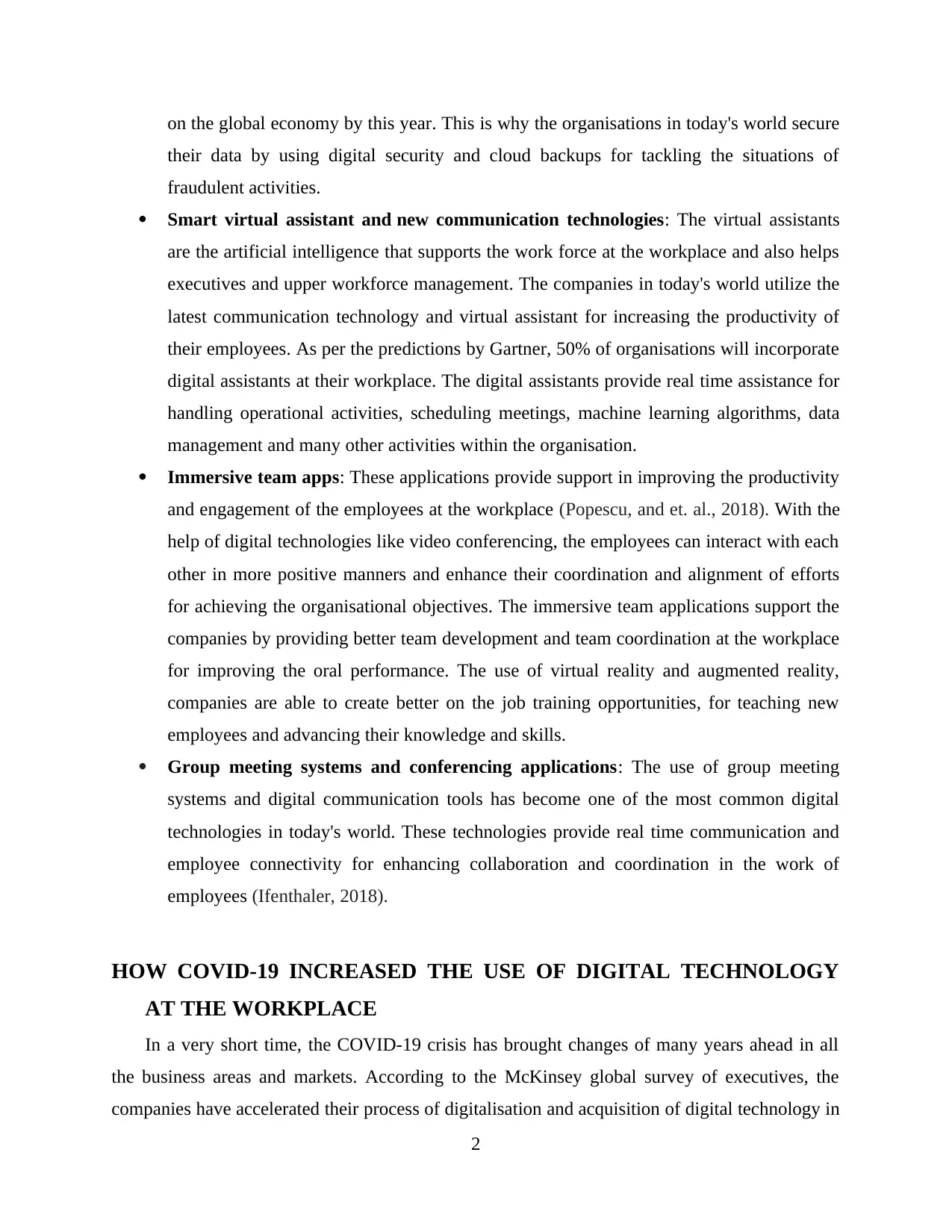
on the global economy by this year. This is why the organisations in today's world secure
their data by using digital security and cloud backups for tackling the situations of
fraudulent activities.
Smart virtual assistant and new communication technologies: The virtual assistants
are the artificial intelligence that supports the work force at the workplace and also helps
executives and upper workforce management. The companies in today's world utilize the
latest communication technology and virtual assistant for increasing the productivity of
their employees. As per the predictions by Gartner, 50% of organisations will incorporate
digital assistants at their workplace. The digital assistants provide real time assistance for
handling operational activities, scheduling meetings, machine learning algorithms, data
management and many other activities within the organisation.
Immersive team apps: These applications provide support in improving the productivity
and engagement of the employees at the workplace (Popescu, and et. al., 2018). With the
help of digital technologies like video conferencing, the employees can interact with each
other in more positive manners and enhance their coordination and alignment of efforts
for achieving the organisational objectives. The immersive team applications support the
companies by providing better team development and team coordination at the workplace
for improving the oral performance. The use of virtual reality and augmented reality,
companies are able to create better on the job training opportunities, for teaching new
employees and advancing their knowledge and skills.
Group meeting systems and conferencing applications: The use of group meeting
systems and digital communication tools has become one of the most common digital
technologies in today's world. These technologies provide real time communication and
employee connectivity for enhancing collaboration and coordination in the work of
employees (Ifenthaler, 2018).
HOW COVID-19 INCREASED THE USE OF DIGITAL TECHNOLOGY
AT THE WORKPLACE
In a very short time, the COVID-19 crisis has brought changes of many years ahead in all
the business areas and markets. According to the McKinsey global survey of executives, the
companies have accelerated their process of digitalisation and acquisition of digital technology in
2
their data by using digital security and cloud backups for tackling the situations of
fraudulent activities.
Smart virtual assistant and new communication technologies: The virtual assistants
are the artificial intelligence that supports the work force at the workplace and also helps
executives and upper workforce management. The companies in today's world utilize the
latest communication technology and virtual assistant for increasing the productivity of
their employees. As per the predictions by Gartner, 50% of organisations will incorporate
digital assistants at their workplace. The digital assistants provide real time assistance for
handling operational activities, scheduling meetings, machine learning algorithms, data
management and many other activities within the organisation.
Immersive team apps: These applications provide support in improving the productivity
and engagement of the employees at the workplace (Popescu, and et. al., 2018). With the
help of digital technologies like video conferencing, the employees can interact with each
other in more positive manners and enhance their coordination and alignment of efforts
for achieving the organisational objectives. The immersive team applications support the
companies by providing better team development and team coordination at the workplace
for improving the oral performance. The use of virtual reality and augmented reality,
companies are able to create better on the job training opportunities, for teaching new
employees and advancing their knowledge and skills.
Group meeting systems and conferencing applications: The use of group meeting
systems and digital communication tools has become one of the most common digital
technologies in today's world. These technologies provide real time communication and
employee connectivity for enhancing collaboration and coordination in the work of
employees (Ifenthaler, 2018).
HOW COVID-19 INCREASED THE USE OF DIGITAL TECHNOLOGY
AT THE WORKPLACE
In a very short time, the COVID-19 crisis has brought changes of many years ahead in all
the business areas and markets. According to the McKinsey global survey of executives, the
companies have accelerated their process of digitalisation and acquisition of digital technology in
2
Paraphrase This Document
Need a fresh take? Get an instant paraphrase of this document with our AI Paraphraser
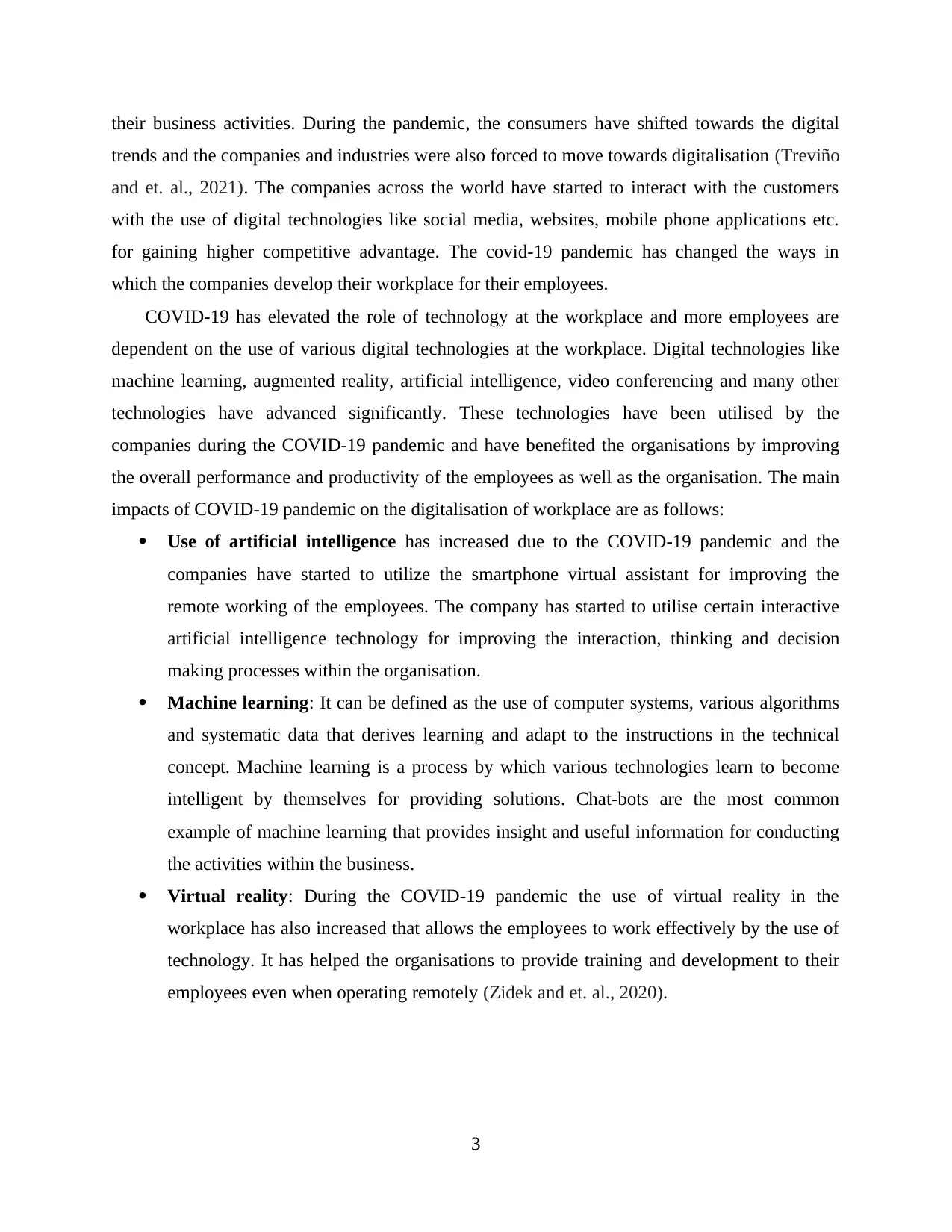
their business activities. During the pandemic, the consumers have shifted towards the digital
trends and the companies and industries were also forced to move towards digitalisation (Treviño
and et. al., 2021). The companies across the world have started to interact with the customers
with the use of digital technologies like social media, websites, mobile phone applications etc.
for gaining higher competitive advantage. The covid-19 pandemic has changed the ways in
which the companies develop their workplace for their employees.
COVID-19 has elevated the role of technology at the workplace and more employees are
dependent on the use of various digital technologies at the workplace. Digital technologies like
machine learning, augmented reality, artificial intelligence, video conferencing and many other
technologies have advanced significantly. These technologies have been utilised by the
companies during the COVID-19 pandemic and have benefited the organisations by improving
the overall performance and productivity of the employees as well as the organisation. The main
impacts of COVID-19 pandemic on the digitalisation of workplace are as follows:
Use of artificial intelligence has increased due to the COVID-19 pandemic and the
companies have started to utilize the smartphone virtual assistant for improving the
remote working of the employees. The company has started to utilise certain interactive
artificial intelligence technology for improving the interaction, thinking and decision
making processes within the organisation.
Machine learning: It can be defined as the use of computer systems, various algorithms
and systematic data that derives learning and adapt to the instructions in the technical
concept. Machine learning is a process by which various technologies learn to become
intelligent by themselves for providing solutions. Chat-bots are the most common
example of machine learning that provides insight and useful information for conducting
the activities within the business.
Virtual reality: During the COVID-19 pandemic the use of virtual reality in the
workplace has also increased that allows the employees to work effectively by the use of
technology. It has helped the organisations to provide training and development to their
employees even when operating remotely (Zidek and et. al., 2020).
3
trends and the companies and industries were also forced to move towards digitalisation (Treviño
and et. al., 2021). The companies across the world have started to interact with the customers
with the use of digital technologies like social media, websites, mobile phone applications etc.
for gaining higher competitive advantage. The covid-19 pandemic has changed the ways in
which the companies develop their workplace for their employees.
COVID-19 has elevated the role of technology at the workplace and more employees are
dependent on the use of various digital technologies at the workplace. Digital technologies like
machine learning, augmented reality, artificial intelligence, video conferencing and many other
technologies have advanced significantly. These technologies have been utilised by the
companies during the COVID-19 pandemic and have benefited the organisations by improving
the overall performance and productivity of the employees as well as the organisation. The main
impacts of COVID-19 pandemic on the digitalisation of workplace are as follows:
Use of artificial intelligence has increased due to the COVID-19 pandemic and the
companies have started to utilize the smartphone virtual assistant for improving the
remote working of the employees. The company has started to utilise certain interactive
artificial intelligence technology for improving the interaction, thinking and decision
making processes within the organisation.
Machine learning: It can be defined as the use of computer systems, various algorithms
and systematic data that derives learning and adapt to the instructions in the technical
concept. Machine learning is a process by which various technologies learn to become
intelligent by themselves for providing solutions. Chat-bots are the most common
example of machine learning that provides insight and useful information for conducting
the activities within the business.
Virtual reality: During the COVID-19 pandemic the use of virtual reality in the
workplace has also increased that allows the employees to work effectively by the use of
technology. It has helped the organisations to provide training and development to their
employees even when operating remotely (Zidek and et. al., 2020).
3
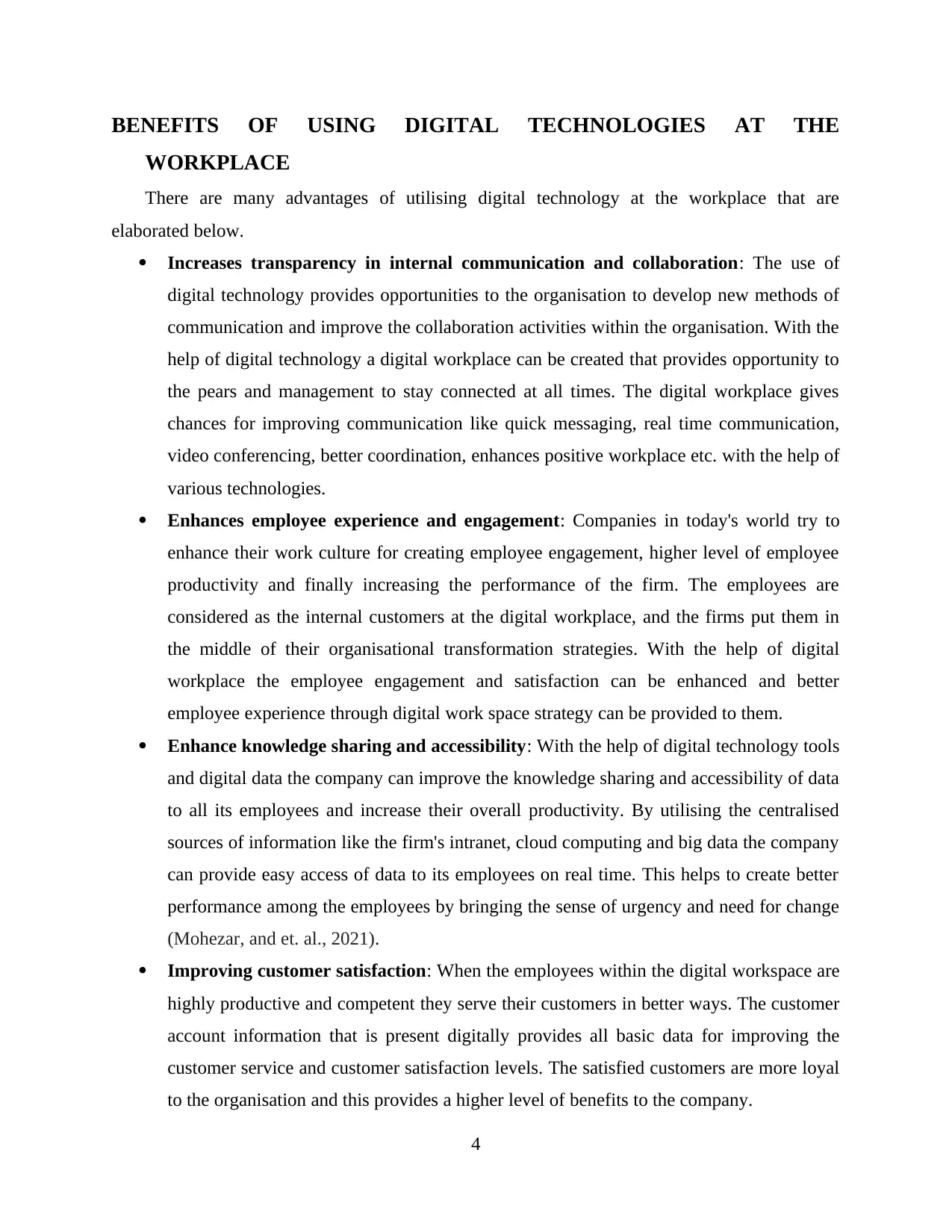
BENEFITS OF USING DIGITAL TECHNOLOGIES AT THE
WORKPLACE
There are many advantages of utilising digital technology at the workplace that are
elaborated below.
Increases transparency in internal communication and collaboration: The use of
digital technology provides opportunities to the organisation to develop new methods of
communication and improve the collaboration activities within the organisation. With the
help of digital technology a digital workplace can be created that provides opportunity to
the pears and management to stay connected at all times. The digital workplace gives
chances for improving communication like quick messaging, real time communication,
video conferencing, better coordination, enhances positive workplace etc. with the help of
various technologies.
Enhances employee experience and engagement: Companies in today's world try to
enhance their work culture for creating employee engagement, higher level of employee
productivity and finally increasing the performance of the firm. The employees are
considered as the internal customers at the digital workplace, and the firms put them in
the middle of their organisational transformation strategies. With the help of digital
workplace the employee engagement and satisfaction can be enhanced and better
employee experience through digital work space strategy can be provided to them.
Enhance knowledge sharing and accessibility: With the help of digital technology tools
and digital data the company can improve the knowledge sharing and accessibility of data
to all its employees and increase their overall productivity. By utilising the centralised
sources of information like the firm's intranet, cloud computing and big data the company
can provide easy access of data to its employees on real time. This helps to create better
performance among the employees by bringing the sense of urgency and need for change
(Mohezar, and et. al., 2021).
Improving customer satisfaction: When the employees within the digital workspace are
highly productive and competent they serve their customers in better ways. The customer
account information that is present digitally provides all basic data for improving the
customer service and customer satisfaction levels. The satisfied customers are more loyal
to the organisation and this provides a higher level of benefits to the company.
4
WORKPLACE
There are many advantages of utilising digital technology at the workplace that are
elaborated below.
Increases transparency in internal communication and collaboration: The use of
digital technology provides opportunities to the organisation to develop new methods of
communication and improve the collaboration activities within the organisation. With the
help of digital technology a digital workplace can be created that provides opportunity to
the pears and management to stay connected at all times. The digital workplace gives
chances for improving communication like quick messaging, real time communication,
video conferencing, better coordination, enhances positive workplace etc. with the help of
various technologies.
Enhances employee experience and engagement: Companies in today's world try to
enhance their work culture for creating employee engagement, higher level of employee
productivity and finally increasing the performance of the firm. The employees are
considered as the internal customers at the digital workplace, and the firms put them in
the middle of their organisational transformation strategies. With the help of digital
workplace the employee engagement and satisfaction can be enhanced and better
employee experience through digital work space strategy can be provided to them.
Enhance knowledge sharing and accessibility: With the help of digital technology tools
and digital data the company can improve the knowledge sharing and accessibility of data
to all its employees and increase their overall productivity. By utilising the centralised
sources of information like the firm's intranet, cloud computing and big data the company
can provide easy access of data to its employees on real time. This helps to create better
performance among the employees by bringing the sense of urgency and need for change
(Mohezar, and et. al., 2021).
Improving customer satisfaction: When the employees within the digital workspace are
highly productive and competent they serve their customers in better ways. The customer
account information that is present digitally provides all basic data for improving the
customer service and customer satisfaction levels. The satisfied customers are more loyal
to the organisation and this provides a higher level of benefits to the company.
4
⊘ This is a preview!⊘
Do you want full access?
Subscribe today to unlock all pages.

Trusted by 1+ million students worldwide
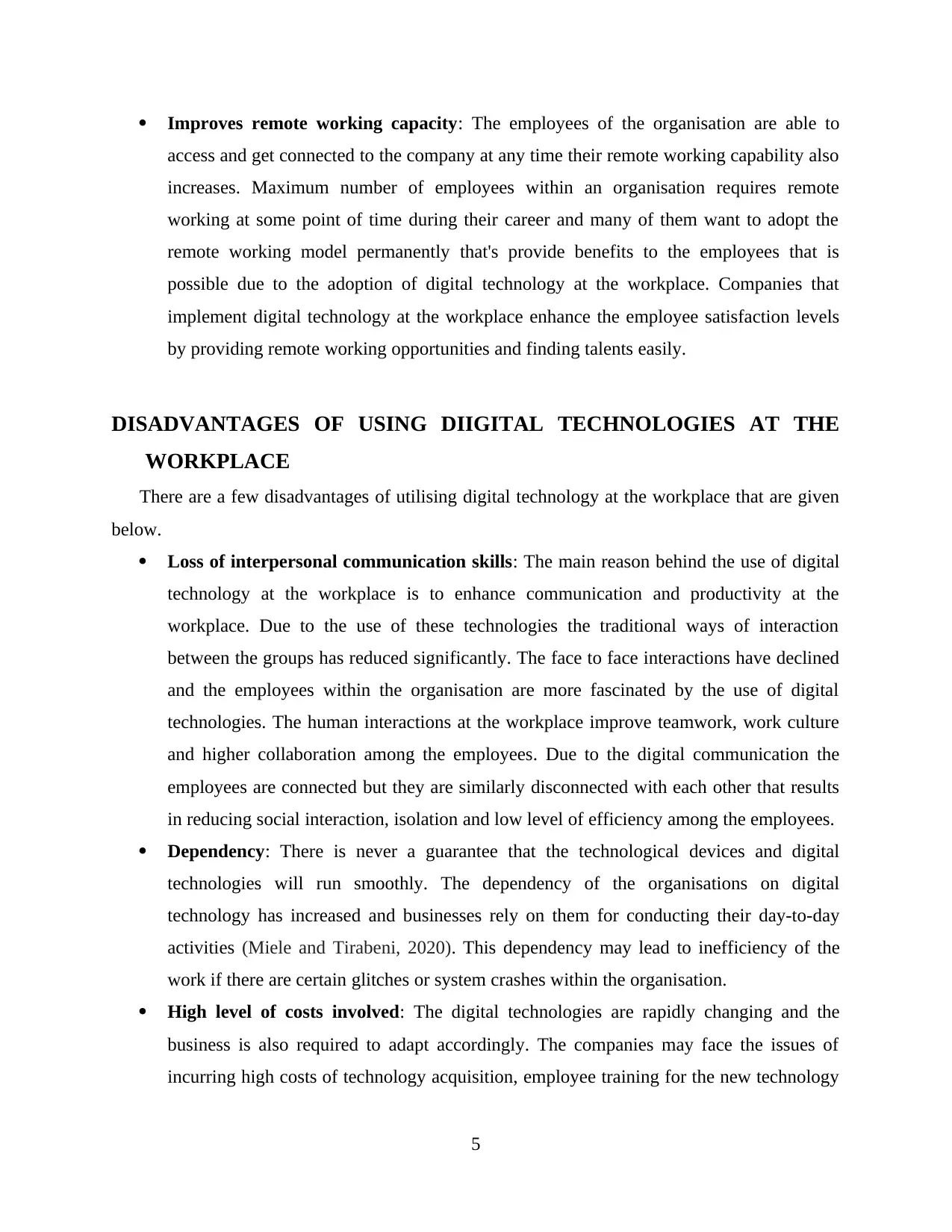
Improves remote working capacity: The employees of the organisation are able to
access and get connected to the company at any time their remote working capability also
increases. Maximum number of employees within an organisation requires remote
working at some point of time during their career and many of them want to adopt the
remote working model permanently that's provide benefits to the employees that is
possible due to the adoption of digital technology at the workplace. Companies that
implement digital technology at the workplace enhance the employee satisfaction levels
by providing remote working opportunities and finding talents easily.
DISADVANTAGES OF USING DIIGITAL TECHNOLOGIES AT THE
WORKPLACE
There are a few disadvantages of utilising digital technology at the workplace that are given
below.
Loss of interpersonal communication skills: The main reason behind the use of digital
technology at the workplace is to enhance communication and productivity at the
workplace. Due to the use of these technologies the traditional ways of interaction
between the groups has reduced significantly. The face to face interactions have declined
and the employees within the organisation are more fascinated by the use of digital
technologies. The human interactions at the workplace improve teamwork, work culture
and higher collaboration among the employees. Due to the digital communication the
employees are connected but they are similarly disconnected with each other that results
in reducing social interaction, isolation and low level of efficiency among the employees.
Dependency: There is never a guarantee that the technological devices and digital
technologies will run smoothly. The dependency of the organisations on digital
technology has increased and businesses rely on them for conducting their day-to-day
activities (Miele and Tirabeni, 2020). This dependency may lead to inefficiency of the
work if there are certain glitches or system crashes within the organisation.
High level of costs involved: The digital technologies are rapidly changing and the
business is also required to adapt accordingly. The companies may face the issues of
incurring high costs of technology acquisition, employee training for the new technology
5
access and get connected to the company at any time their remote working capability also
increases. Maximum number of employees within an organisation requires remote
working at some point of time during their career and many of them want to adopt the
remote working model permanently that's provide benefits to the employees that is
possible due to the adoption of digital technology at the workplace. Companies that
implement digital technology at the workplace enhance the employee satisfaction levels
by providing remote working opportunities and finding talents easily.
DISADVANTAGES OF USING DIIGITAL TECHNOLOGIES AT THE
WORKPLACE
There are a few disadvantages of utilising digital technology at the workplace that are given
below.
Loss of interpersonal communication skills: The main reason behind the use of digital
technology at the workplace is to enhance communication and productivity at the
workplace. Due to the use of these technologies the traditional ways of interaction
between the groups has reduced significantly. The face to face interactions have declined
and the employees within the organisation are more fascinated by the use of digital
technologies. The human interactions at the workplace improve teamwork, work culture
and higher collaboration among the employees. Due to the digital communication the
employees are connected but they are similarly disconnected with each other that results
in reducing social interaction, isolation and low level of efficiency among the employees.
Dependency: There is never a guarantee that the technological devices and digital
technologies will run smoothly. The dependency of the organisations on digital
technology has increased and businesses rely on them for conducting their day-to-day
activities (Miele and Tirabeni, 2020). This dependency may lead to inefficiency of the
work if there are certain glitches or system crashes within the organisation.
High level of costs involved: The digital technologies are rapidly changing and the
business is also required to adapt accordingly. The companies may face the issues of
incurring high costs of technology acquisition, employee training for the new technology
5
Paraphrase This Document
Need a fresh take? Get an instant paraphrase of this document with our AI Paraphraser
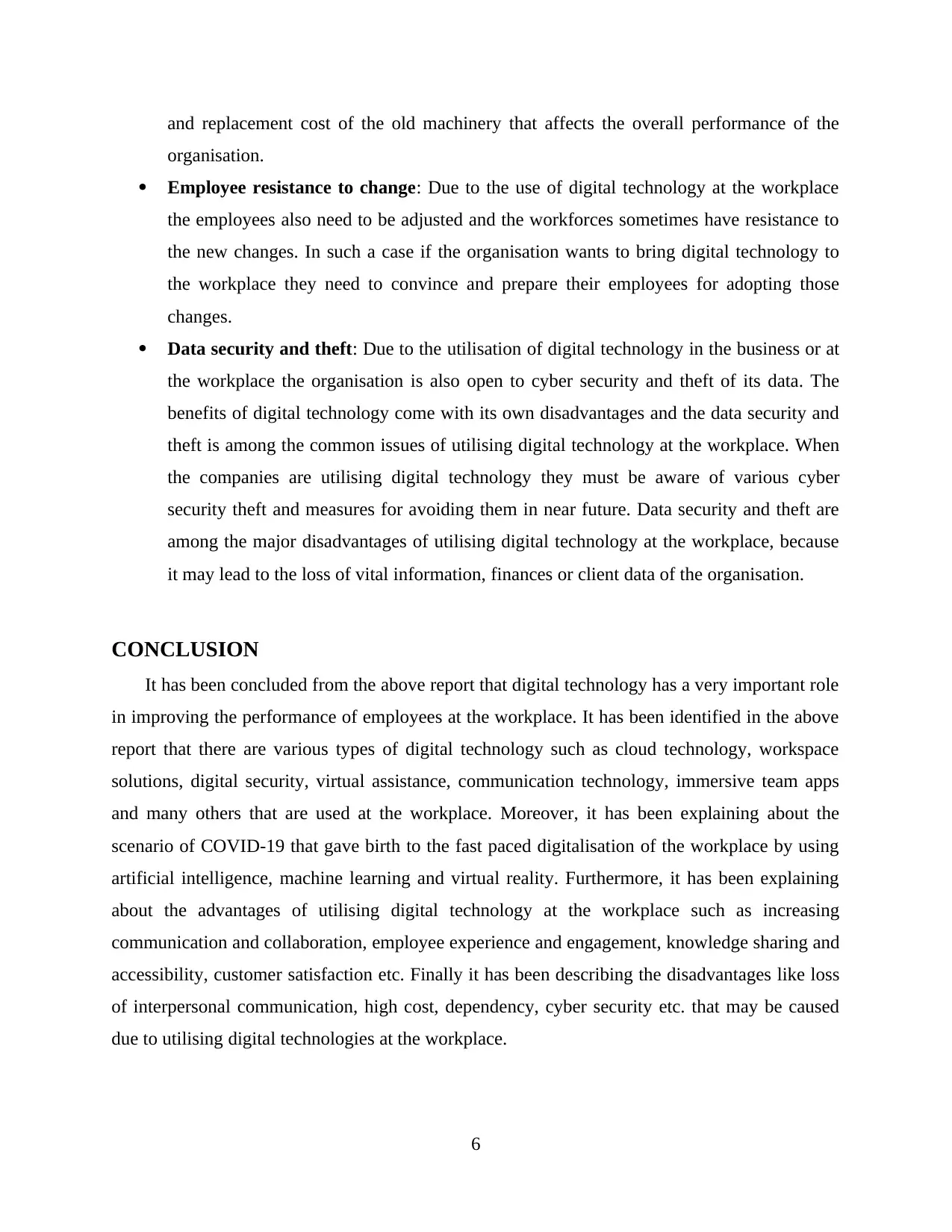
and replacement cost of the old machinery that affects the overall performance of the
organisation.
Employee resistance to change: Due to the use of digital technology at the workplace
the employees also need to be adjusted and the workforces sometimes have resistance to
the new changes. In such a case if the organisation wants to bring digital technology to
the workplace they need to convince and prepare their employees for adopting those
changes.
Data security and theft: Due to the utilisation of digital technology in the business or at
the workplace the organisation is also open to cyber security and theft of its data. The
benefits of digital technology come with its own disadvantages and the data security and
theft is among the common issues of utilising digital technology at the workplace. When
the companies are utilising digital technology they must be aware of various cyber
security theft and measures for avoiding them in near future. Data security and theft are
among the major disadvantages of utilising digital technology at the workplace, because
it may lead to the loss of vital information, finances or client data of the organisation.
CONCLUSION
It has been concluded from the above report that digital technology has a very important role
in improving the performance of employees at the workplace. It has been identified in the above
report that there are various types of digital technology such as cloud technology, workspace
solutions, digital security, virtual assistance, communication technology, immersive team apps
and many others that are used at the workplace. Moreover, it has been explaining about the
scenario of COVID-19 that gave birth to the fast paced digitalisation of the workplace by using
artificial intelligence, machine learning and virtual reality. Furthermore, it has been explaining
about the advantages of utilising digital technology at the workplace such as increasing
communication and collaboration, employee experience and engagement, knowledge sharing and
accessibility, customer satisfaction etc. Finally it has been describing the disadvantages like loss
of interpersonal communication, high cost, dependency, cyber security etc. that may be caused
due to utilising digital technologies at the workplace.
6
organisation.
Employee resistance to change: Due to the use of digital technology at the workplace
the employees also need to be adjusted and the workforces sometimes have resistance to
the new changes. In such a case if the organisation wants to bring digital technology to
the workplace they need to convince and prepare their employees for adopting those
changes.
Data security and theft: Due to the utilisation of digital technology in the business or at
the workplace the organisation is also open to cyber security and theft of its data. The
benefits of digital technology come with its own disadvantages and the data security and
theft is among the common issues of utilising digital technology at the workplace. When
the companies are utilising digital technology they must be aware of various cyber
security theft and measures for avoiding them in near future. Data security and theft are
among the major disadvantages of utilising digital technology at the workplace, because
it may lead to the loss of vital information, finances or client data of the organisation.
CONCLUSION
It has been concluded from the above report that digital technology has a very important role
in improving the performance of employees at the workplace. It has been identified in the above
report that there are various types of digital technology such as cloud technology, workspace
solutions, digital security, virtual assistance, communication technology, immersive team apps
and many others that are used at the workplace. Moreover, it has been explaining about the
scenario of COVID-19 that gave birth to the fast paced digitalisation of the workplace by using
artificial intelligence, machine learning and virtual reality. Furthermore, it has been explaining
about the advantages of utilising digital technology at the workplace such as increasing
communication and collaboration, employee experience and engagement, knowledge sharing and
accessibility, customer satisfaction etc. Finally it has been describing the disadvantages like loss
of interpersonal communication, high cost, dependency, cyber security etc. that may be caused
due to utilising digital technologies at the workplace.
6
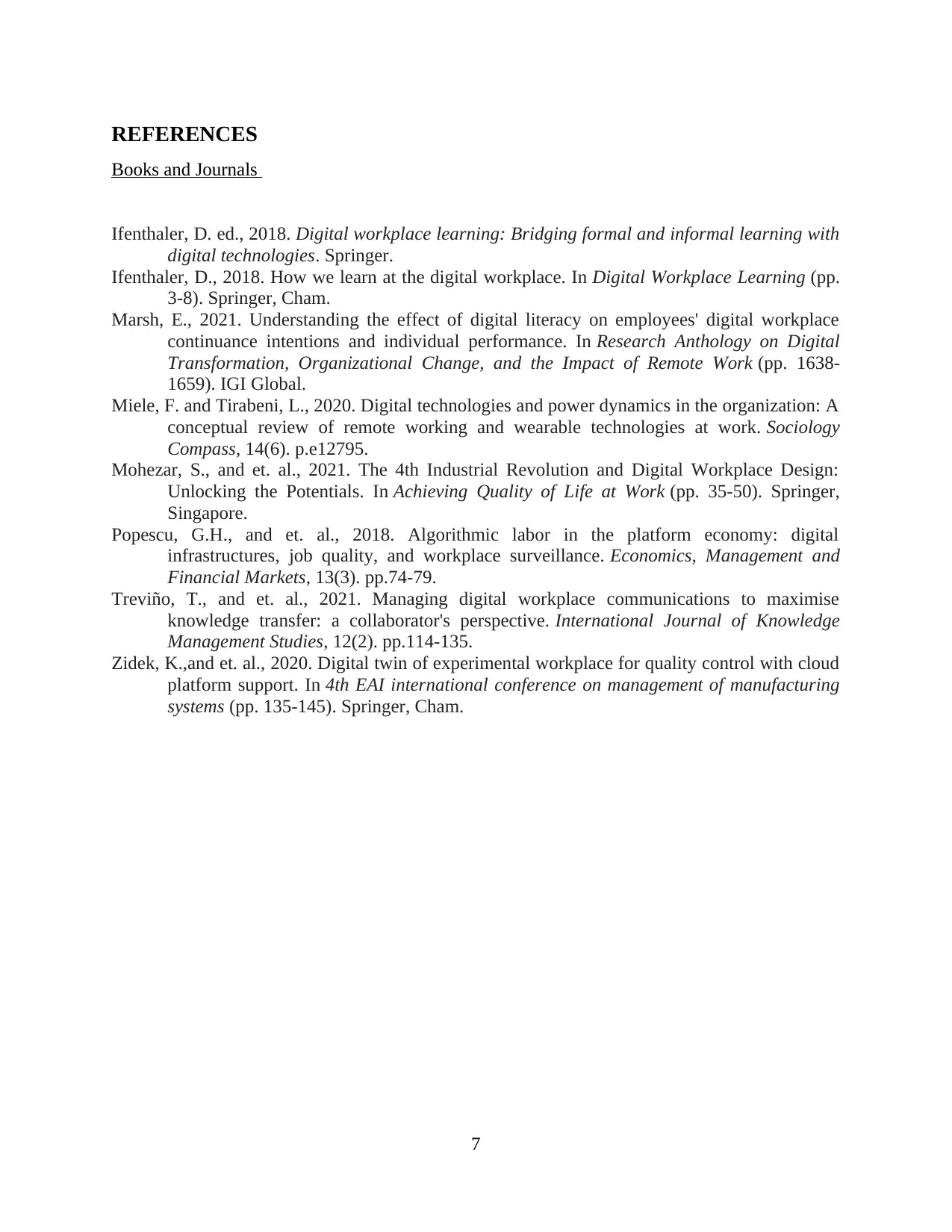
REFERENCES
Books and Journals
Ifenthaler, D. ed., 2018. Digital workplace learning: Bridging formal and informal learning with
digital technologies. Springer.
Ifenthaler, D., 2018. How we learn at the digital workplace. In Digital Workplace Learning (pp.
3-8). Springer, Cham.
Marsh, E., 2021. Understanding the effect of digital literacy on employees' digital workplace
continuance intentions and individual performance. In Research Anthology on Digital
Transformation, Organizational Change, and the Impact of Remote Work (pp. 1638-
1659). IGI Global.
Miele, F. and Tirabeni, L., 2020. Digital technologies and power dynamics in the organization: A
conceptual review of remote working and wearable technologies at work. Sociology
Compass, 14(6). p.e12795.
Mohezar, S., and et. al., 2021. The 4th Industrial Revolution and Digital Workplace Design:
Unlocking the Potentials. In Achieving Quality of Life at Work (pp. 35-50). Springer,
Singapore.
Popescu, G.H., and et. al., 2018. Algorithmic labor in the platform economy: digital
infrastructures, job quality, and workplace surveillance. Economics, Management and
Financial Markets, 13(3). pp.74-79.
Treviño, T., and et. al., 2021. Managing digital workplace communications to maximise
knowledge transfer: a collaborator's perspective. International Journal of Knowledge
Management Studies, 12(2). pp.114-135.
Zidek, K.,and et. al., 2020. Digital twin of experimental workplace for quality control with cloud
platform support. In 4th EAI international conference on management of manufacturing
systems (pp. 135-145). Springer, Cham.
7
Books and Journals
Ifenthaler, D. ed., 2018. Digital workplace learning: Bridging formal and informal learning with
digital technologies. Springer.
Ifenthaler, D., 2018. How we learn at the digital workplace. In Digital Workplace Learning (pp.
3-8). Springer, Cham.
Marsh, E., 2021. Understanding the effect of digital literacy on employees' digital workplace
continuance intentions and individual performance. In Research Anthology on Digital
Transformation, Organizational Change, and the Impact of Remote Work (pp. 1638-
1659). IGI Global.
Miele, F. and Tirabeni, L., 2020. Digital technologies and power dynamics in the organization: A
conceptual review of remote working and wearable technologies at work. Sociology
Compass, 14(6). p.e12795.
Mohezar, S., and et. al., 2021. The 4th Industrial Revolution and Digital Workplace Design:
Unlocking the Potentials. In Achieving Quality of Life at Work (pp. 35-50). Springer,
Singapore.
Popescu, G.H., and et. al., 2018. Algorithmic labor in the platform economy: digital
infrastructures, job quality, and workplace surveillance. Economics, Management and
Financial Markets, 13(3). pp.74-79.
Treviño, T., and et. al., 2021. Managing digital workplace communications to maximise
knowledge transfer: a collaborator's perspective. International Journal of Knowledge
Management Studies, 12(2). pp.114-135.
Zidek, K.,and et. al., 2020. Digital twin of experimental workplace for quality control with cloud
platform support. In 4th EAI international conference on management of manufacturing
systems (pp. 135-145). Springer, Cham.
7
⊘ This is a preview!⊘
Do you want full access?
Subscribe today to unlock all pages.

Trusted by 1+ million students worldwide
1 out of 9
Related Documents
Your All-in-One AI-Powered Toolkit for Academic Success.
+13062052269
info@desklib.com
Available 24*7 on WhatsApp / Email
![[object Object]](/_next/static/media/star-bottom.7253800d.svg)
Unlock your academic potential
Copyright © 2020–2025 A2Z Services. All Rights Reserved. Developed and managed by ZUCOL.



